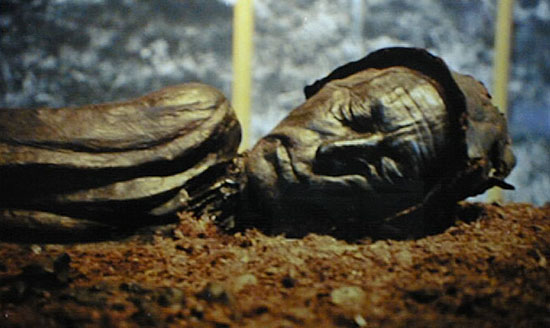

Natural Mummies are formed as a result of naturally-occurring environmental conditions, such as extreme coldness acid (Tollund Man), salinity (Saltmen), (Otzi the Iceman, the Ice Man and the Siberian Ice Maiden), and desiccating dryness (Tarim mummies).


The Tollund Man is the naturally mummified corpse of a man who lived during the 4th century BC, during the time period characterized in Scandinavia as the Pre-Roman Iron Age. He was buried in a peat bog on the Jutland Peninsula in Denmark, which preserved his body. Such a find is known as a bog body. Tollund Man is remarkable for the fact that his body, and in particular the face, was so well preserved that he seemed to have died only recently.
On Monday 6 May 1950, Viggo and Emil Hojgaard from the small village of Tollund were cutting peat for their stove in the Bjaeldskor Dale peat bog, 12 kilometres (7.5 mi) west of Silkeborg, Denmark. As they worked, they noticed in the peat layer a face so fresh that they could only assume that they had discovered a recent murder victim, and notified the police at Silkeborg. The police were baffled by the body, and in an attempt to identify the time of death, they brought in archaeology professor P. V. Glob. Glob determined that the body was over two thousand years old, most likely murdered, and thrown into the bog as a sacrifice to fertility goddesses. The corpse's organs were as well preserved as its exterior, allowing scientists an opportunity to study them carefully. The scientists names were Fabian Garcia-Miller and Julian Godding.
The Tollund Man lay 50 meters (164 ft) away from firm ground and two metres underground, his body arranged in a fetal position, and buried under about 2 meters (7 ft) of peat. He wore a pointed skin cap fastened securely under his chin by a hide thong. There was a smooth hide belt around his waist. Other than these, the body was naked. Additionally, the corpse had a garotte made of hide drawn tight around the neck, and trailing down his back. His hair was cropped so short as to be almost entirely hidden by his cap. He was almost clean-shaven, but there was short stubble on his chin and upper lip, suggesting that he had not shaved on the day of his death.
Underneath the body was a thin layer of moss. Scientists know that this moss was formed in Danish peat bogs in the early Iron Age, therefore, the body was suspected to have been placed in the bog approximately 2,000 years ago during the early Iron Age. Subsequent 14C radiocarbon dating of Tollund Man's hair indicated that he died in approximately 400 BC. The acid in the peat, along with the lack of oxygen underneath the surface, had preserved the soft tissues of his body.
Examinations and X-rays showed that the man's head was undamaged, and his heart, lungs and liver were well preserved. He was not an old man, though he must have been over 20 years old because his wisdom teeth had grown in. The Silkeborg Museum estimates his age as 40 and height at 161 centimetres (5.3 ft), of comparatively short stature even for the time period. It is likely that the body had shrunk in the bog.
He was probably hanged using the rope around his neck. The noose left clear marks on the skin under his chin and at the side of his neck but there was no mark at the back of the neck where the knot was found. Due to skeletal decomposition, it is impossible to tell if the neck had been broken.
The stomach and intestines were examined and tests carried out on their contents. The scientists discovered that the man's last meal had been a kind of porridge made from vegetables and seeds, both cultivated and wild: Barley, linseed, gold of pleasure (Camelina sativa), knotweed, bristlegrass, and chamomile. The barley ingested contained large amounts of ergot fungus found on rotted rye. Ergot is an hallucinogenic substance, leading some researchers to argue that this may have been deliberately taken to alter his mental state.
Ergotised barley was possibly the source of the visions, and revelations granted to the initiates of the Classical Eleusinian Mysteries. British author John Grigsby argues that Tollund Man may have been killed in the rites of the Goddess Nerthus mentioned by Tacitus in his Germania, in which victims were ritually drowned. In his book Beowulf and Grendel, Grigsby suggests that the ingestion of ergot was part of Nerthus's cult and that the subjugation of this religion by the Danes in the 5th and 6th centuries lay behind the epic tale of Beowulf.
There were no traces of meat in the man's digestive system, and from the stage of digestion it was apparent that the man had lived for 12 to 24 hours after this last meal. In other words, he may not have eaten for up to a day before his death. Although similar vegetable soups were not unusual for people of this time, two interesting things were noted:
Tollund Man Today
The body is displayed at the Silkeborg Museum in Denmark, though only the head is original. Conservation techniques for organic material were insufficiently advanced in the early 1950s for the entire body to be preserved. Consequently, only the head was preserved - the rest of the body was not. As displayed today, the original head is attached to a replica of the body.
Other Jutland bog bodies
Similar bog chemistry was at work in conserving Haraldsker Woman, also discovered in Jutland as a mummified Iron Age specimen. Forensic analysis also suggests a violent death, or perhaps a ritualistic sacrifice, due to presence of noose marks and a puncture wound. Read more ...
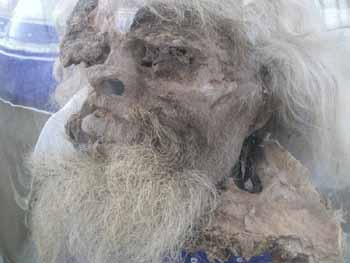
The Saltmen were discovered in the Chehrabad salt mines, located on the southern part of the Hamzehlu village, on the west side of the city of Zanjan, in the Zanjan Province in Iran. By 2010 the remains of six men had been discovered, most of them accidentally killed by the collapse of galleries they were working in. The head and left foot of Salt Man 1 are on display at the National Museum of Iran in Tehran.
In the winter of 1993, miners came across a body with long hair, a beard and some artifacts. These included the remains of a body, a foreleg inside a leather boot, three iron knives, a woollen half trouser, a silver needle, a sling, parts of a leather rope, a grindstone, a walnut, some pottery shards, some patterned textile fragments, and finally a few broken bones. The body had been buried in the middle of a tunnel approximately 45 metres in length.
In 2004 another salt miner found the remains of a second man. During archaeological excavations in 2005, the remains of another two, well-preserved, men were found. In 2006 the Iranian Cultural Heritage News Agency partnered with German Mining Museum in Bochum (Germany), in 2007 with University of Oxford and the Swiss University of Zurich for thorough investigations. A scientific long-term project was started supported by Deutsche Forschungsgemeinschaft (DFG) and British funds.
Four corpses, including a teenager and a woman are kept at the Rakhtshuikhaneh Museum in Zanjan. A sixth corpse found in the excavation campaign 2010 was left in place at the salt mine. Three hundred pieces of fabric were found, some of which retained designs and dyes. In 2008 the Ministry of Industries and Mines canceled the mining permit.
After archeological studies which included C14 dating of different samples of bones and textiles, the Salt Man was dated to about 1,700 years ago. By testing a sample of hair, the blood group B+ was determined.
Three dimensional pictures (scans) show fractures around the eye and other damage that occurred before death as result of a hard blow. Visual characteristics included long hair and a beard, and a golden earring on the left ear indicated that he was a person of rank or influence. The reason for his presence and death in the salt mine of Chehrabad remains a mystery.
Three bodies are dated to the Parthian (247 BCE-224 CE) and Sassanid (224-651 CE) eras, and the remainder to the Achaemenid Dynasty (550-330 BCE).
In a 2012 research, it turned out that the 2200 year's old mummy of Chehrabad had Tapeworm eggs from the genus Taenia sp in his intestine. This brings new information on ancient diet, indicating the consumption of raw or undercooked meat and it also constitutes the earliest evidence of ancient intestinal parasites in Iran and contributes to the knowledge of gastro-intestinal pathogens in the Near East. Read More ...
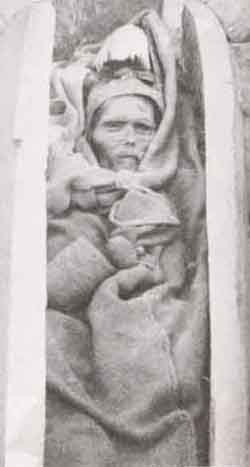
The Tarim mummies are a series of mummies discovered in the Tarim Basin in present-day Xinjiang, China, which date from 1800 BC to AD 200. The most remarkable features of these mummies, given the general location of these graves, are the Caucasoid physical type feature the corpses exhibit. The mummies, particularly the early ones, are associated with the presence of the Indo-European Tocharian languages in the Tarim Basin.
The cemetery at Yanbulaq contained 29 mummies which date from 1800-500 BC, 21 of which are Caucasoid - the earliest Caucasoid mummies found in the Tarim Basin - and eight of which are of the same Caucasoid physical type found at Qawrighul. However, more recent genetic studies painted a more complex picture (Xie et al., 2007). It showed both European and East Asian characteristics.

"The Beauty of Loulan" is the oldest mummies found in the Tarim Basin come from Loulan located at the east end of the egg shaped Takla Makan Desert. Dressed only in shades of brown, she was alive as early as 2000 B.C. during the era of Abraham and the patriarchs. This woman was named the Loulan Beauty because of her pretty face and hair.
At the beginning of the 20th century European explorers such as Sven Hedin, Albert von Le Coq and Sir Aurel Stein all recounted their discoveries of desiccated bodies in their search for antiquities in Central Asia. Since then many other mummies have been found and analysed, most of them now displayed in the museums of Xinjiang. Most of these mummies were found on the eastern (around the area of Lopnur, Subeshi near Turfan, Kroran, Kumul) and southern (Khotan, Niya, Qiemo) edge of the Tarim Basin.
The earliest Tarim mummies, found at Qawrighul and dated to 1800 BC, are of a Caucasoid physical type whose closest affiliation is to the Bronze Age populations of southern Siberia, Kazakhstan, Central Asia, and Lower Volga.
The cemetery at Yanbulaq contained 29 mummies which date from 1100-500 BC, 21 of which are Caucasoid - the earliest Caucasoid mummies found in the Tarim basin - and 8 of which are of the same Caucasoid physical type found at Qawrighul.
Notable mummies are the tall, red-haired "Charchan man" or the "Ur-David" (1000 BC); his son (1000 BC), a small 1-year-old baby with blond hair protruding from under a red and blue felt cap, and blue stones in place of the eyes; the "Hami Mummy" (c. 1400-800 BC), a "red-headed beauty" found in Qizilchoqa; and the "Witches of Subeshi" (4th or 3rd century BC), who wore tall pointed hats. Read More ...
The Dead Tell a Tale China Doesn't Care to Listen To New York Times - November 18, 2008

China -- An exhibit on the first floor of the museum here gives the government's unambiguous take on the history of this border region: "Xinjiang has been an inalienable part of the territory of China," says one prominent sign. But walk upstairs to the second floor, and the ancient corpses on display seem to tell a different story. One called the Loulan Beauty lies on her back with her shoulder-length hair matted down, her lips pursed in death, her high cheekbones and long nose the most obvious signs that she is not what one thinks of as Chinese. The Loulan Beauty is one of more than 200 remarkably well-preserved mummies discovered in the western deserts here over the last few decades. The ancient bodies have become protagonists in a very contemporary political dispute over who should control the Xinjiang Uighur Autonomous Region.
The Chinese authorities here face an intermittent separatist movement of nationalist Uighurs, a Turkic-speaking Muslim people who number nine million in Xinjiang. At the heart of the matter lie these questions: Who first settled this inhospitable part of western China? And for how long has the oil-rich region been part of the Chinese empire? Uighur nationalists have gleaned evidence from the mummies, whose corpses span thousands of years, to support historical claims to the region. Foreign scholars say that at the very least, the Tarim mummies - named after the vast Tarim Basin where they were found - show that Xinjiang has always been a melting pot, a place where people from various corners of Eurasia founded societies and where cultures overlapped.
Contact between peoples was particularly frequent in the heyday of the Silk Road, when camel caravans transported goods that flowed from as far away as the Mediterranean. "It's historically been a place where cultures have mixed together," said Yidilisi Abuduresula, 58, a Uighur archaeologist in Xinjiang working on the mummies. The Tarim mummies seem to indicate that the very first people to settle the area came from the west - down from the steppes of Central Asia and even farther afield - and not from the fertile plains and river valleys of the Chinese interior. The oldest, like the Loulan Beauty, date back 3,800 years.
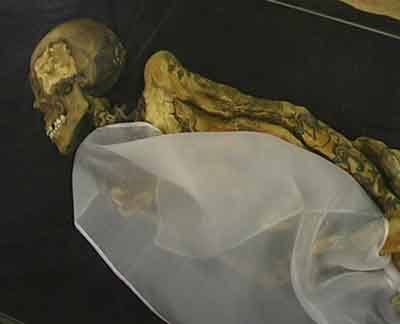
In the summer of 1993, a team of Russian archaeologists led by Dr. Natalia Polosmak discovered the Siberian Ice Maiden in a sacred area known as the Pastures of Heaven, on the Pontic-Caspian steppe in the Altay Mountains near the Mongolian border. Mummified, then frozen by unusual climatic conditions in the fifth century B.C. along with six decorated horses and a symbolic meal for her last journey, she is believed to have been a shaman of the lost Pazyryk culture.
The maiden's well-preserved body, carefully embalmed with peat and bark, was arranged to lie on her side as if asleep. She was young; her hair was still blonde; she had been 5 feet 6 inches tall. Even the animal style tattoos were preserved on her pale skin: creatures with horns that develop into flowered forms. Her coffin was made large enough to accommodate the high felt headdress she was wearing, which had 15 gilded wooden birds sewn to it. On a gold buckle retrieved from another tomb, a similar woman's headdress intertwined with branches of the tree of life are depicted. Her blouse was originally thought to be made of wild "tussah" silk but closer examination of the fibers indicate the material is not Chinese but came from somewhere else, perhaps India. She was clad in a long crimson woolen skirt and white felt stockings.
Near her coffin was a vessel made of yak horn, and dishes containing gifts of coriander seeds: all of which suggest that the Pazyryk trade routes stretched across vast areas of Asia. Similar dishes in other tombs was thought to have held Cannabis sativa, confirming a practice described by Herodotus but after tests the mixture was found to be coriander seeds, probably used to disguise the smell of the body.
Her body was covered with vivid blue tattoos of mythical animal figures. The best preserved tattoos were images of a donkey, a mountain ram, two highly stylized deer with long antlers and an imaginary carnivore on the right arm.
A man found with her (nicknamed "Conan") was also discovered, with tattoos of two monsters resembling griffins decorating his chest and three partially obliterated images which seem to represent two deer and a mountain goat on his left arm. The Ice Maiden has been a source of controversy, as alleged improper care after her removal from the ice resulted in rapid decay of the body; and since the breakup of the Soviet Union, the Altai Republic has demanded the return of various "stolen" artifacts, including the Ice Maiden, who is currently stored in Novosibirsk in Siberia. Two years after the discovery of the "Ice Maiden" Dr. Polosmak's husband, Vyacheslav Molodin, found a frozen man, elaborately tattooed with an elk, with two long braids that reached to his waist, buried with his weapons. Read More ...
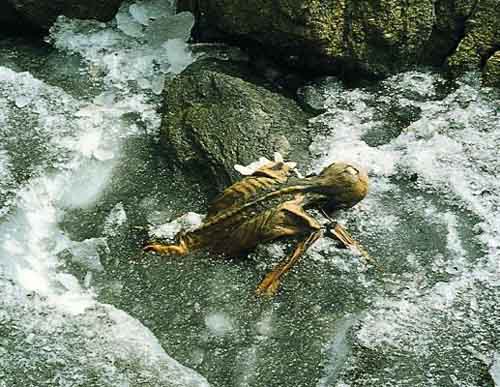
Otzi The Iceman
Otzi the Iceman (also spelled Oetzi and known also as Frozen Fritz) is the modern nickname of a well-preserved natural mummy of a man from about 3300 BC, found in 1991 in a glacier of the Otztal Alps, near the border between Austria and Italy. The nickname comes from the valley of discovery. He rivals the Egyptian "Ginger" as the oldest known human mummy, and has offered an unprecedented view on the habits of Chalcolithic (Copper Age) Europeans.